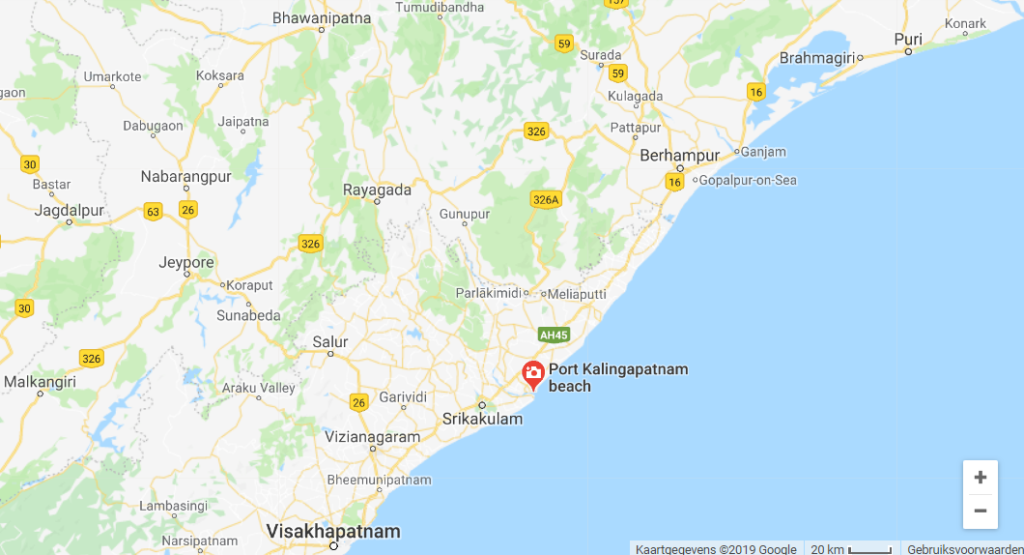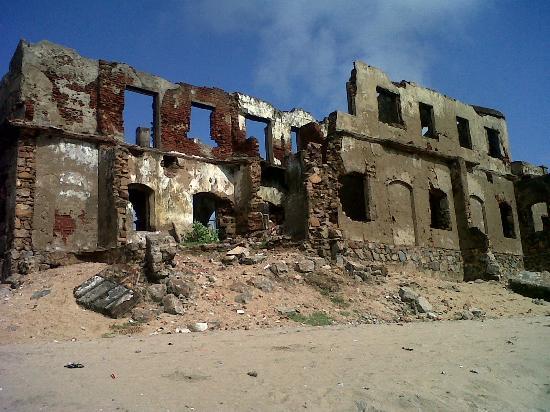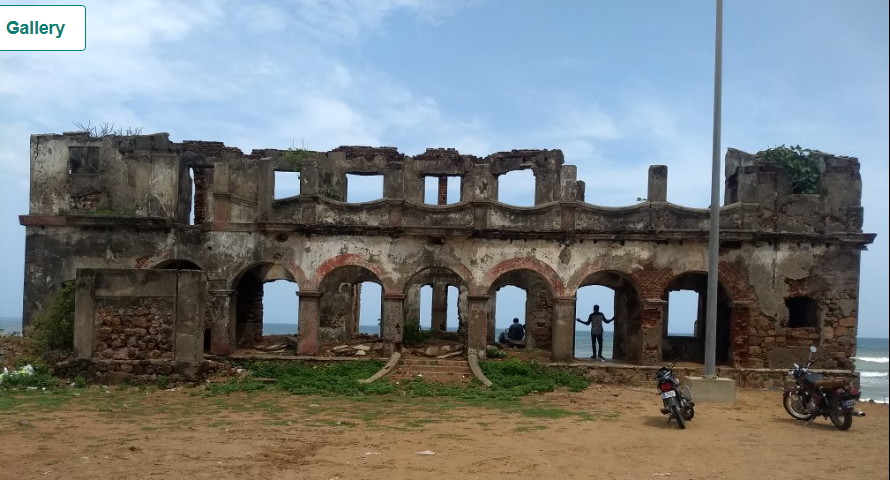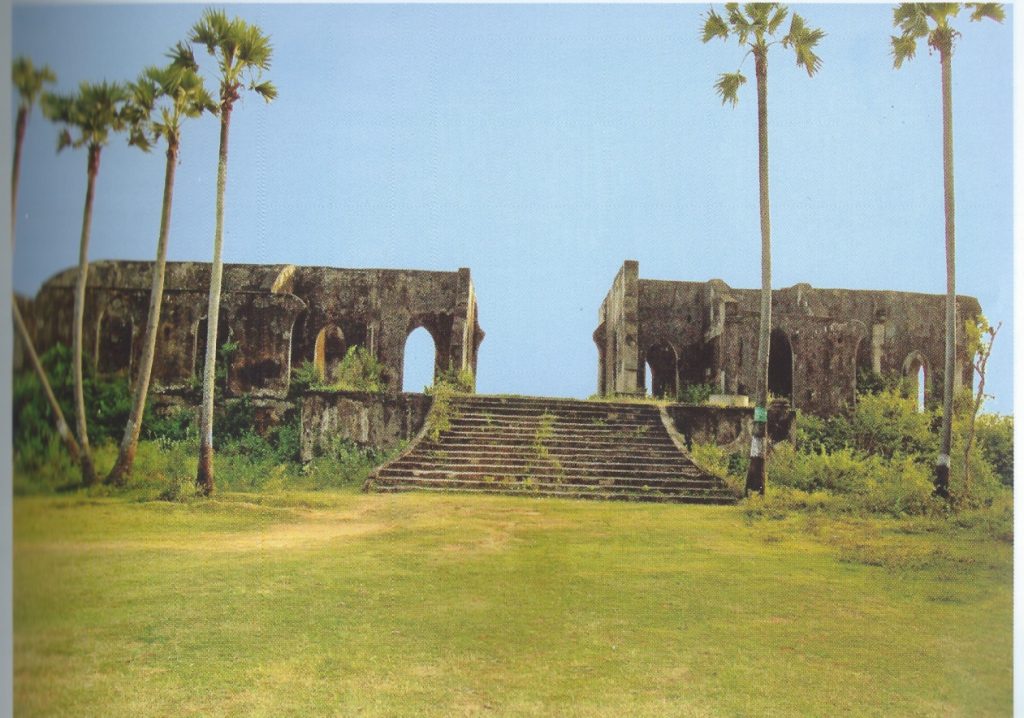When searching information about remains of the former Dutch presence at the East coast south of the Chhilka lake, no academic sources came up, but reportedly, something had to be there. Because of this, we scanned the internet using terms like “old Dutch buildings” plus possible locations. Two buildings came up, one via trip advisor (1) and one via the Hindu newspaper (2). Tripadvisor showed photos by satisfied tourists, and the paper presented an interview by INTACH (3) and the district collector of Srikakulam. The remains of one building are on the beach of Gopalpur on Sea in Ganjam, Odisha. The remains of the other one are by the riverside at Srikakulam, in Andhra Pradesh. These places, and Chilika Lake, are on the map.



The building at Gopalpur on Sea, a seaside and frontend view.
The building at Gopalpur on Sea stands on the sea beach in front of Motel Mermaid. In fact we found two photos, made in 2018 or 2019. Above: seaside; below: roadside. The motel is owned and run by mrs. R.M. Dutt. According to her it was not a warehouse, as some believe, since warehouses used to be situated further north, at Gopalpur Port. More likely, this was a guesthouse-cum-office.
Thereafter dr. Malua and I visited Srikakulam. This picture was in the newspaper article:

From the newspaper article and the work programme of INTACH Srikakulam, we learnt the district collector and INTACH wished to renovate the building, and perhaps turn it into a guest house cum museum. Therefore, dr. Malua and I visited the Collectorate, and could meet the district magistratem J. Nivas, and the INACH convener, K.V.J. Radha Prasad. They presented us with a new edition of the history and heritage of Srikakulam, including the Dutch building (4). The building may first have been used as a guest house, but later perhaps served as a taluk office,where tax and revenues as well as demographic data were accounted for.
Politically these two buildings, some 200 kilometers apart, were related. We do not yet know exactly how, but both Ganjam and Srikakulam (in those days called Cicagole) were part of the kingdom of Golconda. Golconda was ruled by the Qutb Shahi, a dynasty of Shia muslims. As early as 1606, the then Shah granted a firman (concession) to the VOC, in the person of assistant sales manager (onderkoopman) Paulus van Solt, fixing the import and export of goods against a tax rate of 4% (5). Impressive research has been done on the trade lists to and from this region by Om Prakash (6) and Lalatendu Das Mohapatra (7), which will give more information on the contents of this trade.
A wonderful description is available by Dutch traveler Daniel Havart in Golconda (1672-1685), who lived in a villaged between Masulipatnam, and Hyderabad (8). This was turned into a most informative, and downloadable, documentary by Padgaonkar and Kruijtzer (2009). (9)
Golconda, where the Shah lived, was an old mining town famous for the Koh-i-Noor. However, for practical reasons the centre of Golconda was shifted to Hyderabad. The VOC had a comptoir from 1669 to 1687 in Nagulavancha, a weavers’ village halfway Golconda and Masulipatnam, by the Bay of Bengal (10). There, the VOC purchased cotton blankets, chintz (sits), tapestries, leather, iron, and diamonds, while importing ivory and elephants, coffee and tea, and other products (11).
Why did this come to an end? The armies of the Moghul emperor Aurangzeb conquered Hyderabad in 1686. In 1687 Aboe-il-Hossan, the last Qutb Shah, died in Aurangzeb’s prison (12). Basically, this put an end to the firman of the Shah as well, and in 1693 trade by the VOC was allowed no longer. But unrest in Hyderabad, and thereby blackmarketing, was rampant. Nevertheless, In 1697 the number of employees was reduced from 4 Dutch and 76 local, to 2 Dutch and 10 local employees, and between 1730 and 1733, the VOC rejected several requests to continue.
Footnotes
1 Tripadvisor (13-7-2017): Foto”Centuries old houses””. https://www.tripadvisor.co.id/LocationPhotoDirectLink-g1584845-d2266089-i51732836-Gopalpur_Beach-Ganjam_Ganjam_District_Odisha.html
2 The Hindu: Srikakulam, November 02, 1614. URL: https://www.thehindu.com/news/national/andhra-pradesh/Dutch-building-to-be-made-into-tourist-attraction/article11425202.ece
3 INTACH: Indian National Trust for Art and Cultural Heritage:
4 Dusi Dharma Rao (ed.), K.V.J. Radha Prasad (convenor) (2017): Srikakulam, a story on stone …. . INTACH Srikakulam District Chapter, third edition
5 Heeres, J.E. (ed., 1907): Corpus diplomaticum Neerlandico-Indicum. Eerste deel, 1596-1650. ‘s Gravenhage, Martinum Nijhoff, pp. 45-46.
6 Prakash, Om (01985): The Dutch East India Company an the Economy of Bengal, 1630-1720. Princeton University Press.
7 Das Mohapatra, L. (2010): commerce in Orissa, 1600-1800. Prafulla Press.
8 Hoorn, Jan ten (1693): Op- en ondergang van de Coromandel, deel 1: Daniel Havart. (Koninklijke Nederlandse Bibliotheek: digitalized.)
9 Padgaonkar, Nikhil, editing; Kruijtzer, Gijs (script); Simpkins, Robert (consultant)(2009): A Dutch road trip in Golconda. Delhi: Orange Cat Productions .
10 Pol, Bauke van der, (2011): De VOC in India. Zutphen: Walburg Pers, pp. 80-82
11 See: www.devocsite.nl. Handelsposten: de Coromandel, 1/7.
12 – ibid.,- pp. 83-84.